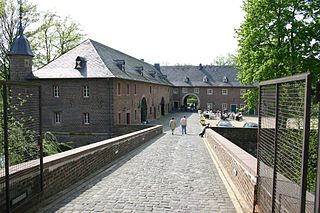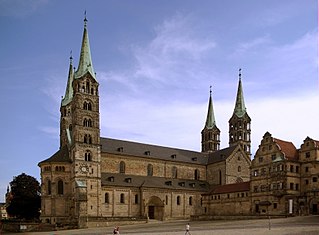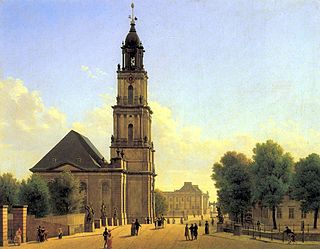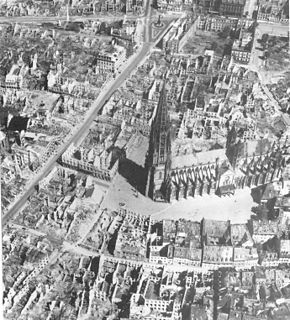
Weimar is a city in the federal state of Thuringia, Germany. It is located in Central Germany between Erfurt in the west and Jena in the east, approximately 80 kilometres southwest of Leipzig, 170 kilometres north of Nuremberg and 170 kilometres west of Dresden. Together with the neighbour cities Erfurt and Jena, it forms the central metropolitan area of Thuringia, with approximately 500,000 inhabitants. The city itself has a population of 65,000. Weimar is well known because of its large cultural heritage and its importance in German history.

Hildesheim[ˈhɪldəsˌhaɪ̯m](listen) is a city in Lower Saxony, Germany with 101,693 inhabitants. It is in the district of Hildesheim, about 30 km (19 mi) southeast of Hanover on the banks of the Innerste River, a small tributary of the Leine River.

The Île de la Cité is an island in the river Seine in the center of Paris. In the 4th century, it was the site of the fortress of the Roman governor. In 508 Clovis I, the first King of the Franks, established his palace on the island. In the 12th century it became an important religious center, the home of Notre-Dame cathedral, and the royal chapel of Sainte-Chapelle, as well as the city's first hospital: the Hôtel-Dieu. It is also the site of the city's oldest surviving bridge, the Pont Neuf.

Albert is a commune in the Somme department in Hauts-de-France in northern France.

Düren is a town in North Rhine-Westphalia, Germany, between Aachen and Cologne on the river Rur.

Rothenburg ob der Tauber is a town in the district of Ansbach of Mittelfranken, the Franconia region of Bavaria, Germany. It is well known for its well-preserved medieval old town, a destination for tourists from around the world. It is part of the popular Romantic Road through southern Germany. Today it is one of only three towns in Germany that still have completely intact city walls, the other two being Nördlingen and Dinkelsbühl.

The Nazi party rally grounds covered about 11 square kilometres in the southeast of Nuremberg, Germany. Six Nazi party rallies were held there between 1933 and 1938.

St. Mary's Church in Lübeck in north Germany was built between 1250 and 1350. It has always been a symbol of the power and prosperity of the old Hanseatic city, and is situated at the highest point of the island that forms the old town of Lübeck. It is part of the UNESCO World Heritage Site of the old Hanseatic City of Lübeck.

The St. Thomas Church is a Lutheran church in Leipzig, Germany. It is associated with several well-known composers such as Richard Wagner and Felix Mendelssohn Bartholdy, and especially Johann Sebastian Bach, who worked here as a Kapellmeister from 1723 until his death in 1750. Today, the church also holds his remains. Martin Luther preached here in 1539.

The Cathedral of St. John the Baptist in Wrocław,, is the seat of the Roman Catholic Archdiocese of Wrocław and a landmark of the city of Wrocław in Poland. The cathedral, located in the Ostrów Tumski district, is a Gothic church with Neo-Gothic additions. The current standing cathedral is the fourth church to have been built on the site.

Hiroshima Peace Memorial Park is a memorial park in the center of Hiroshima, Japan. It is dedicated to the legacy of Hiroshima as the first city in the world to suffer a nuclear attack at the end of World War II, and to the memories of the bomb's direct and indirect victims. The Hiroshima Peace Memorial Park is visited by more than one million people each year. The park is there in memory of the victims of the nuclear attack on August 6, 1945, in which the United States dropped an atomic bomb on the Japanese city of Hiroshima. The Hiroshima Peace Memorial Park was planned and designed by the Japanese Architect Kenzō Tange at Tange Lab.

Bamberg Cathedral is a church in Bamberg, Germany, completed in the 13th century. The cathedral is under the administration of the Roman Catholic Church and is the seat of the Archbishop of Bamberg. Since 1993, the cathedral has been part of the UNESCO World Heritage Site "Town of Bamberg".

Oettingen in Bayern is a town in the Donau-Ries district, in Swabia, Bavaria, Germany. It is situated 29 km (18 mi) northwest of Donauwörth, and 14 km (8.7 mi) northeast of Nördlingen.

Eggenberg Palace in Graz, is the most significant Baroque palace complex in the Austrian province of Styria. With its preserved accouterments, the extensive scenic gardens, as well as some special collections from the Universalmuseum Joanneum housed in the palace and surrounding park, Schloss Eggenberg ranks among the most valuable cultural treasures of Austria. Eggenberg Palace is situated at an elevation of 381 meters on the Western edge of the city. Its architectural design and the still visible imprint of centuries of history continue to bear witness to the vicissitude and patronage of the one-time mightiest dynasty in Styria, the House of Eggenberg.

Münster Cathedral or St.-Paulus-Dom is the cathedral church of the Catholic Diocese of Münster in Germany, and is dedicated to St Paul. It is counted among the most significant church buildings in Münster and, along with the City Hall, is one of the symbols of the city.

The Vienna Museum is a group of museums in Vienna consisting of the museums of the history of the city. In addition to the main building in Karlsplatz and the Hermesvilla, the group includes numerous specialised museums, musicians' residences and archaeological excavations.

The Garrison Church was a Protestant church in the historic centre of Potsdam. Built by order of King Frederick William I of Prussia according to plans by Philipp Gerlach from 1730 to 1735, it was considered as a major work of Prussian Baroque architecture. With a height of almost 90 metres, it was Potsdam's tallest building and shaped its cityscape. In addition, the Garrison Church was part of the city's famous "Three Churches View" together with St. Nicholas Church and Holy Spirit Church. After it was damaged during the British bombing in World War II, the East German authorities demolished the church in 1968. After the German reunification the Garrison Church is currently being rebuilt as a centre for remembrance and reconciliation.

Operation Tigerfish was the military code name in World War II for the air raid on Freiburg in the evening of 27 November 1944 by the Royal Air Force with about 2,800 dead.

The Park an der Ilm is a large Landschaftspark in Weimar, Thuringia. It was created in the 18th century, influenced by Johann Wolfgang von Goethe, and has not been changed much, preserving a park of the period. It forms part of the World Heritage Site "Classical Weimar".

The Chinese Tower is a 25-metre wooden building resembling a pagoda at the Englischer Garten in Munich, Germany. The building was constructed from 1789 to 1790 and was opened to the public as an observation deck during the opening of the Englischer Garten in 1792. The tower burned down during the bombing of Munich during World War II and was reopened as a reconstruction in 1952. Today the tower is considered a landmark of the Englischer Garten.





















